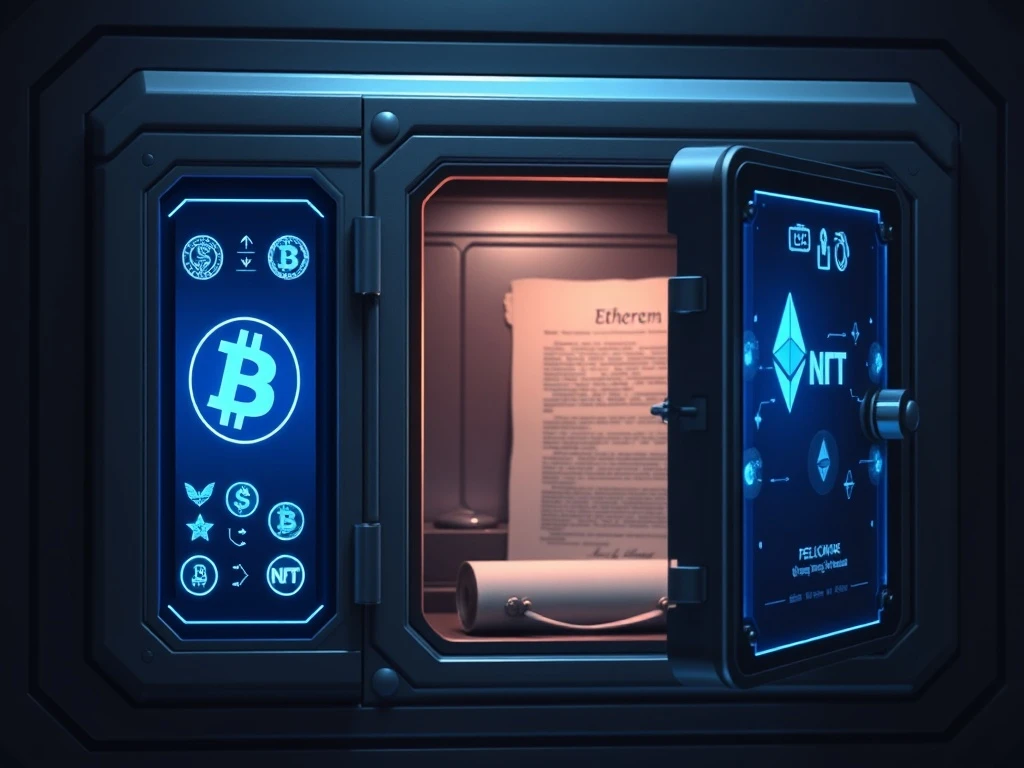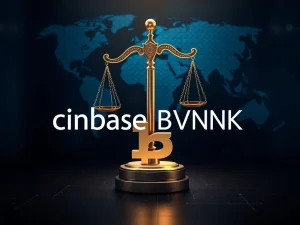Crucial Crypto Inheritance Plan: Safeguard Your Digital Legacy Now

Are you a cryptocurrency holder? Then you understand the thrill and potential of digital assets. However, a critical question often goes unaddressed: what happens to your Bitcoin, altcoins, and NFTs if you are no longer around? Unfortunately, millions in digital wealth are lost annually due to inadequate planning. Therefore, establishing a robust crypto inheritance plan is not merely a recommendation; it is an absolute necessity to protect your digital legacy.
The Urgent Need for a Crypto Inheritance Plan
Owning cryptocurrencies like Bitcoin (BTC) and Ether (ETH) demands a clear, well-structured inheritance plan. Without one, your digital assets could become permanently unrecoverable. Unlike traditional bank accounts, private keys and seed phrases control cryptocurrencies, whether in hot or cold wallets. Losing these keys means your assets vanish forever. Every year, significant cryptocurrency values disappear due to forgotten passwords, misplaced wallets, or heirs lacking access instructions.
Traditional wills often fail to address digital assets adequately. This oversight can lead to legal complications or permanent loss. A carefully designed crypto inheritance plan addresses these challenges. It ensures your assets remain secure and accessible to your beneficiaries, precisely as you intend. This article explores why a crypto inheritance plan is vital, its key components, privacy protection methods, and essential crypto death protocols.
Why Your Digital Assets Need a Dedicated Plan
If you own cryptocurrency, creating a plan is essential. Cryptocurrencies are typically self-custodied. This means only you hold the private keys or seed phrases. If you pass away without sharing this information, your assets could be lost forever. A specific digital asset will ensures proper sharing of altcoins and Bitcoin private keys after death. Estimates suggest around 1.57 million Bitcoin are likely lost, representing about 7.5% of its total supply.
Traditional wills rarely address cryptocurrency requirements. Moreover, heirs often lack the technical skills to access or manage digital wallets. Without clear crypto estate planning, your assets could become unrecoverable. This leaves your family with nothing. A well-designed digital asset will ensures secure crypto transfer after death to your loved ones. Your heirs will know what assets you hold, how to access them, and how to manage them responsibly. Knowing how to pass on crypto safeguards your legacy in a growing digital financial landscape. Did you know? Crypto estate services offer multisignature recovery, secure identity verification, and smart contract-based wills. These features help ensure crypto seamlessly goes to heirs, avoiding chaos from lost access.
Prerequisites for a Secure Crypto Estate Planning Strategy
Building a crypto estate planning strategy protects your digital assets. It ensures they pass to the right people with minimal confusion or risk. Because crypto is self-custodied and irreversible, a clear and secure strategy is vital. It can mean the difference between preserving your legacy or losing it forever. Here are the core foundations you need before designing your crypto inheritance plan:
-
Establish Clear Legal Directives: Begin by consulting an estate planning attorney. Choose one who understands both inheritance law and digital assets. Your crypto holdings should be referenced in legally binding documents. These include a will, trust, or letter of instruction. Be specific about:
- What assets are to be inherited.
- Who the beneficiaries are.
- How the assets should be accessed.
These documents ensure your wishes are legally recognized. They also reduce the risk of disputes or legal barriers later on.
-
Secure and Share Private Key Access Responsibly: Key management presents the biggest challenge in crypto inheritance. Without your private keys or seed phrases, beneficiaries cannot access your assets. Exchanges also cannot help recover them. Consider these options:
- Use multisignature wallets. These require two or more private keys to approve a transaction.
- Distribute key parts among trusted family members or advisers. Shamir’s Secret Sharing is a useful method.
- Store recovery data in secure, tamper-proof locations. Examples include bank safe deposit boxes or encrypted drives.
Always document how and where to find the keys. Ensure your heirs can understand these instructions. This is crucial for private keys security.
- Integrate Smart Contract Automation (Where Supported): In some ecosystems, smart contracts can automate inheritance. They trigger transfers when predefined conditions are met. Examples include verifiable death certificates or time delays. While not available on every chain, platforms like Ethereum support programmable logic. This can complement legal planning. Smart contracts should never replace legal documentation. Instead, use them to enforce your intent transparently and securely.
-
Educate Your Heirs or Trusted Executors: Even the best inheritance plan can fail if beneficiaries do not understand crypto. Take time to:
- Document clear, step-by-step access instructions.
- Explain wallet tools, basic security, and how to avoid scams.
- Designate a trusted, crypto-literate executor to guide the process.
You do not need to disclose balances today. However, education safeguards against future confusion, delay, or loss. Did you know? Forgotten credentials pose a significant risk in crypto inheritance. Proper planning with encrypted backups or secure executors could have preserved crypto worth billions for future heirs.
How to Write a Comprehensive Digital Asset Will
A digital asset will ensures your digital assets transfer securely to beneficiaries. It also maintains privacy and legal compliance. By carefully documenting assets and instructions, you minimize risks. You establish next-of-kin crypto access. Here are general steps to create a crypto will:
- Compile a detailed inventory: List all digital holdings. Include hardware and software wallets, exchange accounts, non-fungible tokens (NFTs), and decentralized finance (DeFi) investments. This provides a clear overview of your assets.
- Secure sensitive information: Avoid including private keys directly in the will. Store them in encrypted files or hardware wallets. Reference access instructions within the document. This is vital for private keys security.
- Provide clear access instructions: Include detailed steps for accessing your digital assets within the will. Ensure beneficiaries can retrieve them securely.
- Appoint a tech-savvy executor: Choose a trusted individual familiar with cryptocurrency. Alternatively, set up a trust to manage and execute the transfer process effectively.
- Ensure legal compliance: Verify that the will aligns with local inheritance and tax laws. This prevents disputes or legal complications.
- Incorporate a digital asset memorandum: Consider adding a memorandum. This outlines specific instructions for your digital assets, enhancing clarity and security.
- Use specialized services: Explore crypto inheritance services. They provide additional security and streamline the transfer process for your beneficiaries.
- Update regularly: Review and revise the will periodically. Reflect changes in your assets or updates to legal requirements. This ensures ongoing accuracy.
Remember to account for inheritance tax on Bitcoin and other crypto assets. This is an important step when setting up your crypto inheritance plan.
Protecting Privacy in Your Crypto Inheritance Plan
Preparing for the future is essential. Safeguarding your privacy during this process is equally important. When creating a digital asset will, sharing sensitive information can lead to risks. Here is how to protect your personal and digital information while ensuring posthumous crypto recovery:
- Avoid sensitive details in public wills: Do not list private keys, wallet addresses, or access codes in public legal documents. Instead, acknowledge the existence of digital assets without disclosing specifics.
- Use sealed letters or encrypted files: Provide critical access information through sealed envelopes or encrypted documents. Ensure only trusted individuals can access it when needed. This method significantly enhances private keys security.
- Explore decentralized identity tools for secure access: Utilize decentralized identifiers (DIDs) or verifiable credentials. These tools help manage and transfer access rights across platforms safely. This ensures long-term security for your Bitcoin inheritance and other assets.
Regular Review and Updates for Your Crypto Estate Planning
A cryptocurrency inheritance plan requires ongoing attention. It is not a one-time setup. Digital assets and personal circumstances constantly evolve. Regular updates, aligned with your crypto legal advice, are crucial. They keep your plan accurate and effective. Here are reasons why you should review and update your crypto estate planning at regular intervals:
- Cryptocurrency values and holdings may shift: The value of digital currencies can change significantly. You may buy or sell assets over time. Periodic reviews ensure your plan reflects your current portfolio.
- Wallets and exchanges may become outdated: Technology advances quickly. Some wallets or crypto exchanges may close, lose relevance, or stop supporting specific tokens. Ensure your instructions remain practical and up to date.
- Revise the plan after major life events: Events like marriage, divorce, or the birth of a new heir affect your intended beneficiaries or asset distribution. Update your digital asset will after such events. This keeps it legally and personally relevant.
Did you know? Crypto enthusiasts sometimes set up “dead man’s switches.” These systems automatically transfer funds if the owner does not log in for a set time. While ingenious, they must be paired with legal documents. This avoids disputes and accidental early triggers.
Custodial vs. Non-Custodial Wallets in Your Crypto Inheritance Plan
Establishing a crypto inheritance plan requires understanding the distinction between custodial and non-custodial wallets. Custodial wallets are managed by third parties, such as exchanges. These entities hold the private keys. While this might simplify access for heirs with proper documentation, it carries risks. These risks include hacks, account freezes, or service termination. For example, relying solely on an exchange for your Bitcoin inheritance might expose it to platform-specific vulnerabilities.
Conversely, non-custodial wallets offer users complete control. They store private keys locally. These wallets are excellent for long-term security. However, they demand meticulous planning. If heirs misplace the seed phrase or lack technical expertise, assets may become inaccessible. For inheritance, a balanced strategy is often optimal. Non-custodial wallets provide greater security and full control. Custodial services, however, can lead to easier transfers in certain scenarios.
Comparison of Crypto Inheritance Setups with Custodial and Non-Custodial Wallets
| Feature | Custodial Wallets (e.g., Exchanges) | Non-Custodial Wallets (e.g., Hardware Wallets) |
|---|---|---|
| Key Control | Third-party holds private keys | User holds private keys |
| Access for Heirs | Easier with proper legal documents and platform support | Requires seed phrase/private keys and technical understanding |
| Security Risks | Hacks, account freezes, platform insolvency | Loss of seed phrase, user error, physical damage |
| Complexity for Heirs | Lower, if platform provides support | Higher, requires crypto knowledge |
| Privacy | Lower, identity often linked to account | Higher, transactions are pseudonymous |
| Best Use for Inheritance | Smaller amounts, simpler transfers, part of a diversified plan | Larger amounts, long-term holdings, primary for private keys security |
How to Avoid Common Crypto Inheritance Mistakes
Setting up a cryptocurrency inheritance plan is essential. However, certain errors can compromise its efficacy. Avoiding these mistakes helps ensure your assets remain secure and accessible when needed. Here are common mistakes you should avoid when setting up a crypto inheritance plan:
- Including seed phrases in wills or unsecured documents: Listing private keys or seed phrases in public or unprotected documents risks theft or misuse. Instead, use encrypted storage or secure, offline methods. This is a fundamental aspect of private keys security.
- Not training heirs: Even with thorough documentation, heirs unfamiliar with cryptocurrency may struggle to access or manage assets. Provide clear instructions regarding wallets and transfers.
- Relying heavily on centralized exchanges: Exchanges may face closures, hacks, or account freezes. This makes them unreliable for long-term storage. Opt for self-custody solutions or trusted multisignature wallets for enhanced security. This is especially true for significant Bitcoin inheritance holdings.
Crypto Estate Planning: Safeguarding Your Digital Wealth
A clear and secure digital asset will provides confidence. It removes uncertainty for both asset holders and their heirs. For holders, it ensures all their digital assets—including BTC, altcoins, NFTs, or DeFi holdings—are not lost. This prevents loss due to forgotten keys, inaccessible wallets, or heirs’ lack of technical expertise. With a robust crypto inheritance plan, records of assets, access instructions, and other legal documents protect your legacy and prevent conflicts.
For beneficiaries, the plan simplifies accessing assets. It spares them the stress of navigating a complex tech landscape they are unfamiliar with. The plan ensures a smooth transfer of wealth. It uses secure storage, trusted executors, and legally compliant documents. This article does not contain investment advice or recommendations. Every investment and trading move involves risk, and readers should conduct their own research when making a decision.
Editor’s Choice Bitcoin whales dump 115,000 BTC in biggest sell-off since mid-2022 Bitcoin taps $111.3K as forecast says 10% dip ‘worst case scenario’ Bitcoin may sink ‘below $50K’ in bear, Justin Sun’s WLFI saga: Hodler’s Digest, Aug. 31 – Sept. 6 Ripple’s SEC battle is over: Time to challenge SWIFT? Blockchain-based identity can help HR navigate AI-generated applications Advertise with us







